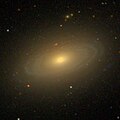NGC 3898
| NGC 3898 | |
|---|---|
 Hubble Space Telescope image of NGC 3898 | |
| Observation data (J2000 epoch) | |
| Constellation | Ursa Major |
| Right ascension | 11h 49m 15.370s[1] |
| Declination | +56° 05′ 03.66″[1] |
| Redshift | 0.003894[2] |
| Heliocentric radial velocity | 1,142.7±13.9 km/s[3] |
| Distance | 72.0 ± 5.8 Mly (22.08 ± 1.79 Mpc)[4] |
| Apparent magnitude (V) | 10.7[5] |
| Apparent magnitude (B) | 11.02[6] |
| Characteristics | |
| Type | SA(s)ab[7] |
| Apparent size (V) | 3.3′ × 1.5′[5] |
| Other designations | |
| IRAS 11465+5621, NGC 3898, UGC 6787, LEDA 36921, MCG +09-19-204[8] | |
NGC 3898 is a spiral galaxy in the constellation Ursa Major that was discovered by William Herschel on April 14, 1789.[9] It is positioned 1.5° northwest of NGC 3998 and is barely visible in a small telescope. The galaxy has an apparent visual magnitude of 10.7 and an angular size of 3.3′ × 1.5′.[5] It is located at a distance of 72 ± 6 million light-years (22.08 ± 1.79 Mpc)[4] from the Milky Way, and is receding with a heliocentric radial velocity of 1,142.7±13.9 km/s.[3]
The morphological classification of NGC 3898 in the De Vaucouleurs system is SA(s)ab,[6] which indicates this is a spiral galaxy with no central bar (SA) or inner ring system (s) and tightly wound spiral arms (ab). It is gas rich and serves as the prototype of an Sa galaxy with flocculent arms.[10] The galactic plane is inclined at an angle of 68°±4° to the plane of the sky,[4] with the major axis oriented along a position angle of 107°. The nucleus is intermediate between an H II region and a LINER.[11]
There is a small, irregular galaxy, UGC 6816, located at an angular separation of 26′ from NGC 3898.[10]
Gallery
[edit]-
NGC 3898 (SDSS DR14)
-
NGC 3898 with the legacy surveys
References
[edit]- ^ a b Skrutskie, Michael F.; et al. (1 February 2006). "The Two Micron All Sky Survey (2MASS)". The Astronomical Journal. 131 (2): 1163–1183. Bibcode:2006AJ....131.1163S. doi:10.1086/498708. ISSN 0004-6256. S2CID 18913331.
- ^ Wang, Li-Li; et al. (February 2018). "Spectral classification and composites of galaxies in LAMOST DR4". Monthly Notices of the Royal Astronomical Society. 474 (2): 1873–1885. arXiv:1710.10611. Bibcode:2018MNRAS.474.1873W. doi:10.1093/mnras/stx2798.
- ^ a b van den Bosch, Remco C. E.; et al. (May 2015). "Hunting for Supermassive Black Holes in Nearby Galaxies With the Hobby-Eberly Telescope". The Astrophysical Journal Supplement Series. 218 (1): 13. arXiv:1502.00632. Bibcode:2015ApJS..218...10V. doi:10.1088/0067-0049/218/1/10. S2CID 117876537. 10.
- ^ a b c Kourkchi, Ehsan; et al. (October 23, 2020). "Cosmicflows-4: The Catalog of ∼10,000 Tully–Fisher Distances". The Astrophysical Journal. 902 (2): 145. arXiv:2009.00733. Bibcode:2020ApJ...902..145K. doi:10.3847/1538-4357/abb66b. ISSN 1538-4357.
- ^ a b c O'Meara, Stephen James (2007), Herschel 400 Observing Guide, Cambridge University Press, pp. 100–101, ISBN 9780521858939.
- ^ a b Barbon, R.; et al. (April 1978). "Photographic photometry of bright galaxies. V. NGC 3898 and NGC 4036". Astronomy and Astrophysics. 65 (2): 165–172. Bibcode:1978A&A....65..165B.
- ^ "NASA/IPAC Extragalactic Database". ned.ipac.caltech.edu. Retrieved 19 June 2019.
- ^ "NGC 3898". SIMBAD. Centre de données astronomiques de Strasbourg. Retrieved 19 June 2019.
- ^ Seligman, Courtney. "New General Catalog Objects: NGC 3850 - 3899". Celestial Atlas. Retrieved 19 June 2019.
- ^ a b van Driel, W.; van Woerden, H. (June 1994). "Distribution and motions of H I in the SA galaxies NGC 1169 and NGC 3898". Astronomy and Astrophysics. 286: 395–407. Bibcode:1994A&A...286..395V.
- ^ Pignatelli, E.; et al. (May 2001). "Modelling gaseous and stellar kinematics in the disc galaxies NGC 772, 3898 and 7782". Monthly Notices of the Royal Astronomical Society. 323 (1): 188–210. arXiv:astro-ph/0011146. Bibcode:2001MNRAS.323..188P. doi:10.1046/j.1365-8711.2001.04207.x.
External links
[edit] Media related to NGC 3898 at Wikimedia Commons
Media related to NGC 3898 at Wikimedia Commons- NGC 3898 on WikiSky: DSS2, SDSS, GALEX, IRAS, Hydrogen α, X-Ray, Astrophoto, Sky Map, Articles and images


